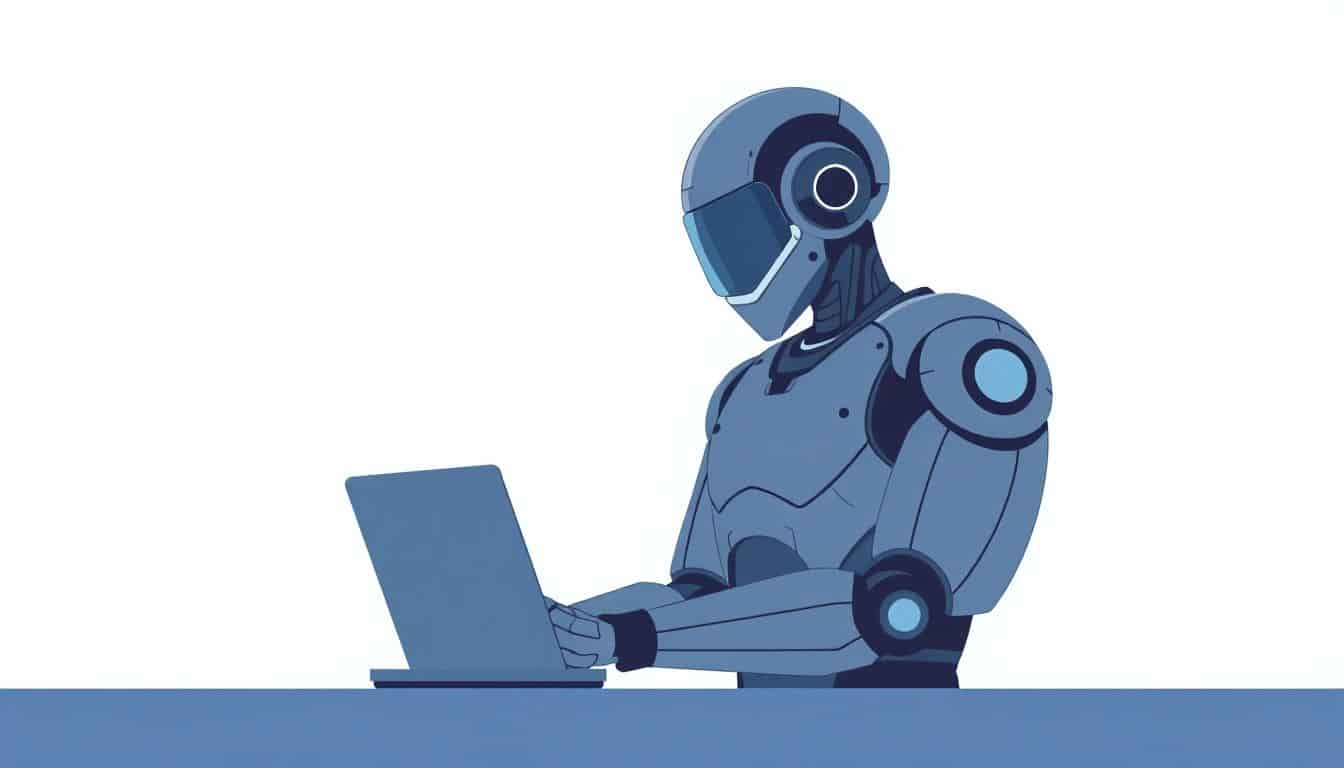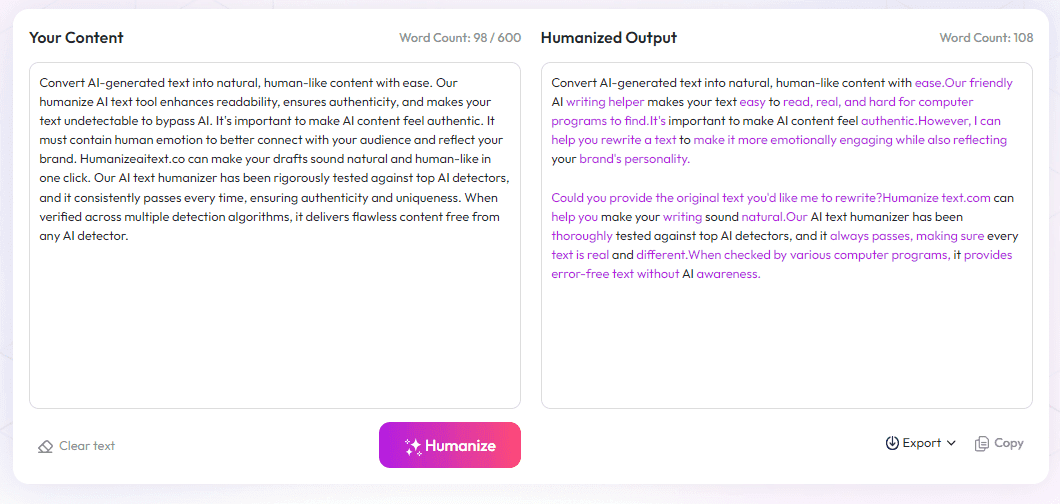Table of Contents
Many people feel unsure about how AI and humans can team up effectively. They worry that AI might take over or that human skills could weaken with too much reliance. If you're curious about how working together can actually boost results without losing what makes us human, keep reading. I’ll show you the real perks of teaming up with AI and how to make it work smoothly.
In this chat, I’ll highlight what AI does really well—like crunching data fast—and what humans shine at, such as creativity and emotional insight. Then, I’ll tell you how combining these strengths can lead to better productivity and smarter results. So, whether you’re just starting or looking to improve your team, you'll find simple ways to make AI and people work better together.
Key Takeaways
Key Takeaways
- In 2024, working with AI is essential as most knowledge workers already use AI tools daily. Combining AI’s speed with human judgment boosts productivity and results.
- AI is good at handling numbers, repetitive tasks, and generating content quickly, but humans excel at understanding context, making decisions, and showing empathy.
- The best results come when AI automates routine work and humans focus on strategy, creativity, and emotional understanding, especially in roles like customer service or content creation.
- Effective teamwork depends on knowing where AI adds value and where human skills are needed. Clear boundaries and oversight prevent errors and overreliance.
- Training, clear roles, and proper tools are key to building successful human-AI partnerships in organizations.
- Relying too much on AI can weaken important skills like critical thinking and judgment. Regular human skill development keeps teams sharp.
- Design workflows that let AI handle data and repetitive tasks, while humans develop ideas, interpret insights, and manage complex problems for best results.

1. Why Collaboration Between AI and Humans Matters More Than Ever
In today’s fast-changing work environment, teaming up with AI is no longer a nice-to-have—it's a must. As of mid-2024, about 75% of global knowledge workers use AI tools at their jobs, often even before their companies roll out formal plans (source). This shows just how naturally AI is becoming part of our daily routines.
Why is this partnership so crucial right now? For one thing, AI can handle data-heavy tasks efficiently, freeing up humans to focus on areas where judgment, creativity, and deep understanding are needed. It’s like giving workers a high-powered toolkit, but they still need to decide how to best use it.
Another reason? AI is rapidly evolving, and 76% of employees believe it will create brand-new skill sets. This shift demands that humans and AI learn to work side-by-side, each bringing their strengths to the table. When we combine human intuition with AI’s speed, we can see results that neither could achieve alone.
However, many organizations haven't fully prepared for this wave. Only 39% have provided training on AI tools, even though 78% of users are bringing their own AI solutions (source). This gap leaves workers relying on their own savvy, sometimes without proper guidance.
2. What AI Excels At Compared to Humans
AI is exceptionally good at processing large amounts of data quickly. Tasks like sorting customer information, generating routine reports, or automating basic customer service are where AI shines brightest (source). For instance, AI can analyze thousands of sales records in seconds, uncovering patterns that might take humans days or weeks.
Another strength of AI? Consistency. Unlike humans, AI doesn’t get tired, distracted, or emotional. It consistently follows rules and algorithms, making it ideal for repetitive tasks like data entry, scheduling, or inventory management (source).
Furthermore, AI's capacity to generate content—like basic drafts, summaries, or even creative ideas—can accelerate workflows. For example, AI-driven tools can craft initial versions of marketing copy or beta story plots, saving creative teams time for polishing.
3. What Humans Do Best in Working With AI
Humans excel at providing context, making judgments, and applying creativity—skills no AI can fully replicate yet. When working with AI, it's essential for humans to interpret data insights, ask meaningful questions, and decide on the best course of action (source).
Humans also bring empathy, ethics, and nuanced understanding to decisions. For example, customer service reps can use AI-generated data to better support clients, but they need human empathy to handle complex or delicate situations.
One of the smartest moves is for humans to guide AI outputs—validating accuracy, adjusting biases, and ensuring results align with values. This oversight makes the collaboration more trustworthy and effective.
4. How Combining AI and Human Strengths Increases Productivity and Results
When AI handles automation and data crunching, humans are freed up to focus on strategy, innovation, and relationship-building. This duo speeds up workflows, reduces errors, and unlocks new opportunities (source).
For example, a marketing team might use AI to generate numerous content ideas rapidly, then human writers select and refine the best concepts. The result? Faster campaigns with more creative finesse.
Organizations that foster this partnership often see higher engagement, better decision-making, and increased efficiency. Data shows that frequent AI use has almost doubled from 11% in 2023 to 19% in 2024 (source), proving how integrated this collaboration has become.
In short, combining human judgment with AI capabilities allows teams to achieve more with less effort. Yet, realizing this potential depends on smart strategies and proper setup. Next, we’ll explore the best areas for human-AI teamwork and how to make it work for you.

5. The Best Areas for Human-AI Collaboration Explained
Some work areas lend themselves naturally to collaboration between humans and AI, like customer support, content creation, and data analysis.
Customer service teams can use AI to handle routine inquiries, freeing up reps to focus on complex or emotional issues that need a human touch.
Content creators can rely on AI for brainstorming, initial drafts, or editing, but the final polish still benefits from human judgment and style.
Data analysis is another field where AI can process large datasets quickly, but humans interpret those insights to make strategic decisions.
Sales and marketing teams use AI for targeting and personalization, while humans develop the messaging and emotional appeal.
Understanding where AI adds value and where humans provide the crucial nuance can help guide effective teamwork.
6. When Human-AI Collaboration Works Well and When It Doesn’t
AI works best when it automates repetitive tasks or processes large amounts of data efficiently.
On the flip side, collaboration tends to falter when AI is asked to handle tasks requiring deep empathy, nuanced judgment, or complex problem-solving.
For example, relying solely on AI for managing sensitive customer complaints can backfire if emotional intelligence is needed.
Similarly, AI might produce plausible but inaccurate outputs if not properly overseen, leading to misinformation or errors.
Clear boundaries and knowing what roles AI can and can’t handle help teams avoid overdependence and mistakes.
Being aware of these limitations makes human oversight an essential part of successful AI integration.
7. How to Set Up Effective Human-AI Teams in Your Organization
Start with identifying specific tasks where AI can genuinely add value, such as automation, data processing, or initial drafts.
Next, ensure your team is trained on how to interact with AI tools—this fosters confidence and minimizes misuse.
Develop clear protocols for oversight, validation, and feedback to keep AI outputs on track.
Encourage open communication so humans and AI systems can adapt and improve together over time.
Invest in the right tools and platforms that promote collaboration rather than just automation for automation’s sake.
Finally, foster a culture that views AI as an aid, not a replacement, in work processes.
8. Risks of Relying Too Much on AI and Ways to Keep Human Skills Strong
Overdependence on AI can lead to skill erosion, especially in areas like critical thinking, judgment, and creativity.
If teams rely solely on AI for decision-making, they may lose the ability to analyze issues deeply or spot errors.
To avoid this, keep regular training programs that sharpen human skills and ensure team members understand the limits of AI.
Incorporate exercises that challenge human judgment, like scenario planning, creative problem solving, or ethical debates.
Remember, AI should enhance human capabilities, not replace the need for continuous learning and skill development.
Getting regular feedback and encouraging curiosity helps keep skills fresh and adaptable.
9. Key Strategies for Successfully Using AI and Humans Together in 2025
Focus on designing workflows where AI handles the routine, and humans tackle the strategic, creative, or emotional parts of work.
Set clear expectations around roles, responsibilities, and oversight for both AI tools and team members.
Use AI to provide insights and recommendations, but validate and interpret them with human judgment.
Prioritize transparency by explaining how AI decisions are made, especially in customer-facing or sensitive situations.
Make ongoing training a priority—regularly update your team on new AI features and best practices.
Finally, continually assess and refine collaboration strategies based on feedback and evolving technology capabilities.
FAQs
Combining human creativity and judgment with AI's processing power addresses complex challenges more effectively, driving innovation and better decision-making in today's fast-paced environment.
AI excels at analyzing large data sets quickly, identifying patterns, and automating repetitive tasks, freeing humans to focus on strategic and creative work that requires intuition.
Humans should provide context, interpret AI outputs, make ethical decisions, and apply creativity and emotional intelligence that AI cannot replicate effectively.
Blending AI's speed with human insight enhances accuracy, accelerates workflows, and leads to more innovative solutions, boosting overall productivity and outcomes effectively.



